Paul Gilster's Blog, page 233
January 22, 2013
Deep Space Industries: Mining Near-Earth Asteroids
Deep Space Industries is announcing today that it will be engaged in asteroid prospecting through a fleet of small ‘Firefly’ spacecraft based on cubesat technologies, cutting the costs still further by launching in combination with communications satellites. The idea is to explore the small asteroids that come close to Earth, which exist in large numbers indeed. JPL analysts have concluded that as many as 100,000 Near Earth Objects larger than the Tunguska impactor (some 30 meters wide) are to be found, with roughly 7000 identified so far. So there’s no shortage of targets (see Greg Matloff’s Deflecting Asteroids in IEEE Spectrum for more on this.
‘Smaller, cheaper, faster’ is a one-time NASA mantra that DSI is now resurrecting through its Firefly spacecraft, each of which masses about 25 kilograms and takes advantages of advances in computing and miniaturization. In its initial announcement, company chairman Rick Tumlinson talked about a production line of Fireflies ready for action whenever an NEO came near the Earth. The first launches are slated to begin in 2015. Sample-return missions that are estimated to take between two and four years to complete are to commence the following year, with 25 to 70 kilograms of asteroid material becoming available for study. Absent a fiery plunge through the atmosphere, such samples will have their primordial composition and structure intact.

The Deep Space Industries announcement is to be streamed live later today. It will reflect the company’s ambitious game plan, one that relies on public involvement and corporate sponsorship to move the ball forward. David Gump is CEO of the new venture:
“The public will participate in FireFly and DragonFly missions via live feeds from Mission Control, online courses in asteroid mining sponsored by corporate marketers, and other innovative ways to open the doors wide. The Google Lunar X Prize, Unilever, and Red Bull each are spending tens of millions of dollars on space sponsorships, so the opportunity to sponsor a FireFly expedition into deep space will be enticing.”
The vision of exploiting space resources to forge a permanent presence there will not be unfamiliar to Centauri Dreams readers. Tumlinson sums up the agenda:
“We will only be visitors in space until we learn how to live off the land there. This is the Deep Space mission – to find, harvest and process the resources of space to help save our civilization and support the expansion of humanity beyond the Earth – and doing so in a step by step manner that leverages off our space legacy to create an amazing and hopeful future for humanity. We are squarely focused on giving new generations the opportunity to change not only this world, but all the worlds of tomorrow. Sounds like fun, doesn’t it?”
So we have asteroid sample return as part of the mix, but the larger strategy calls for the use of asteroid-derived products to power up space industries. The company talks about using asteroid-derived propellants to supply eventual manned missions to Mars and elsewhere, with Gump likening nearby asteroid resources to the Iron Range of Minnesota, which supplied Detroit’s car industry in the 20th Century. DSI foresees supplying propellant to communication satellites to extend their working lifetime, estimating that each extra month is worth $5 million to $8 million per satellite. The vision extends to harvesting building materials for subsequent technologies like space-based power stations. Like I said, the key word is ‘ambitious.’
“Mining asteroids for rare metals alone isn’t economical, but makes sense if you already are processing them for volatiles and bulk metals for in-space uses,” said Mark Sonter, a member of the DSI Board of Directors. “Turning asteroids into propellant and building materials damages no ecospheres since they are lifeless rocks left over from the formation of the solar system. Several hundred thousand that cross near Earth are available.”
In the near-term category, the company has a technology it’s calling MicroGravity Foundry that is designed to transform raw asteroid materials into metal parts for space missions. The 3D printer uses lasers to draw patterns in a nickel-charged gas medium, building up parts from the precision placement of nickel deposits. Because it does not require a gravitational field to work, the MicroGravity Foundry could be a tool used by deep space astronauts to create new parts aboard their spacecraft by printing replacements.
The team behind Deep Space Industries has experience in commercial space activities. Tumlinson, a well-known space advocate, was a founding trustee of the X Prize and founder of Orbital Outfitters, a commercial spacesuit company. Gump has done space-related TV work, producing a commercial shot on the International Space Station. He’s also a co-founder of Transformational Space Corporation. Geoffrey Notkin is the star of ‘Meteorite Men,’ a TV series about hunting meteorites. The question will be how successful DSI proves to be in leveraging that background to attract both customers and corporate sponsors.
With such bold objectives, I can only wish Deep Space Industries well. The idea of exploiting inexpensive CubeSat technology and combining it with continuing progress in miniaturizing digital tools is exciting, but the crucial validation will be in those early Firefly missions and the data they return. If DSI can proceed with the heavier sample return missions it now envisions, the competitive world of asteroid prospecting (think Planetary Resources) will have taken another step forward. Can a ‘land rush’ for asteroid resources spark the public’s interest, with all the ramifications that would hold for the future of commercial space? Could it be the beginning of the system-wide infrastructure we’ll have to build before we think of going interstellar?






January 21, 2013
A New Horizons Update
I for one am astounded at the fact that it has been seven years since the launch of New Horizons. The craft, now more than halfway between the orbits of Uranus and Neptune, lifted off on January 19, 2006. I remember my frustration at having hundreds of cable channels on my television and not being able to see the New Horizons launch on any of them. I wound up tracking the event on a balky Internet transmission that, despite freezing up on more than one occasion, still got across the magic of punching this mission out into the deepest parts of the Solar System.
With the flyby at Pluto/Charon in 2015, principal investigator Alan Stern is describing what his team is feeling as ‘the seven year itch,’ a sense of anticipation feeding off the spacecraft’s continued good health along the way. Stern’s latest report is online, noting that the current ‘wake period’ of the spacecraft (New Horizons was in hibernation from July of 2012 until January 6) is proceeding smoothly, including upload of new software. New Horizons goes back to sleep on January 30 and stays under until deep into May, when summer encounter rehearsals begin. We have 903 days until Pluto closest approach.
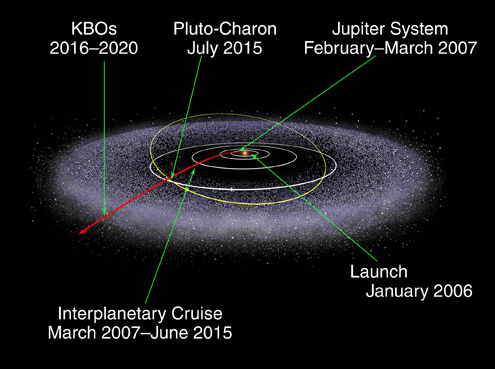
Image: The journey of New Horizons past Pluto/Charon and on into the Kuiper Belt. Credit: JHU/APL.
We should get a lot of updated information about Pluto/Charon this summer when the Johns Hopkins Applied Physics Laboratory hosts a conference devoted to the distant worlds, one that will include planning for the observations that will take place during the all too brief encounter. Stern notes that the question he is most frequently asked about the mission is why New Horizons will not pull into an orbit around Pluto for extended observations, a question easily enough answered:
…getting into orbit isn’t practical because of our speed. Remember, New Horizons was the fastest spacecraft ever launched. Even after climbing uphill against the Sun’s gravity for nine years, when we reach Pluto we’ll still be going 30,000-plus miles per hour — very roughly twice the speed of a space shuttle or satellite in Earth orbit. To enter orbit around Pluto we’d need to bleed almost all of that speed off with rockets. And that would require very large rocket engines and a lot of fuel, given our fast trajectory.
Orbiting Pluto would have made for a much longer flight — decades longer — and in any case pushing on into the Kuiper Belt allows further explorations as the mission continues. This is probably the place to note that although New Horizons left Earth orbit traveling faster than any other vehicle launched into interplanetary space, its 14 kilometer per second speed at Pluto/Charon is below Voyager 1’s 17 kilometers per second-plus — as Stern says, the spacecraft has been climbing out of the gravity well for the last nine years, and slowing.
We turn to Helios II, though, for the title of fastest man-made object, although the Helios probes, launched in 1974 and 1976, were designed to study the Sun rather than to leave the system. Both were placed into highly elliptical orbits that, at closest approach, reached speeds in the range of 70 kilometers per second. It’s worth noting, too, that the upcoming Solar Probe Plus mission, also the work of JHU/APL, would actually triple Helios II’s velocity. Solar Probe Plus is designed to fly into the Sun’s corona for the first time, giving us a wealth of information about how the solar wind is accelerated. If all goes well, the mission will launch in July of 2018.
Slow boat to Centauri? Well, imagine that you could get a spacecraft up to Solar Probe Plus speeds not approaching the Sun but leaving the Solar System, no small feat. Point the craft in the direction of Centauri A and B and you’d be able to make the crossing in a bit over 6000 years. You’re making a good deal less than 1 tenth of one percent of light speed here, with an interstellar ship design that had better be either a worldship or a robotic probe designed for long-haul operations. As always, interstellar distances take the breath away as we ponder even the nearest stars.






January 17, 2013
Pulsar Navigation: Beacons in the Darkness
In a world of search engines, GPS and always-on connectivity, I sometimes wonder what’s happening to serendipity. Over the years, I’ve made some of my best library finds by browsing the stacks, just taking some time off and walking around scanning the book titles. Odd ideas show up, mental connections get forged, and new insights emerge. Targeted searching is generally what we do (think Google), but never forget the value of the odd juxtaposition that comes from random wanderings. Too much targeting can produce tunnel vision.
For that matter, have you noticed how hard it is to get lost these days? I’m just back from Oakland, where Marc Millis and I went for interviews with the History Channel in the gorgeous setting of Chabot Space & Science Center in the hills above the city. The view on the drive up was spectacular, and my guide used an iPad to continually update our position on the map, so getting lost was impossible. My son Miles drove up from his home south of San Francisco and after the interview he drove me back to the hotel, where we met Marc for dinner at a nearby restaurant. All the way down from Chabot, he was keeping one eye on the smartphone he was using for navigation, flawlessly threading his way through streets that were new to him.
Maybe someday the whole idea of getting lost and running into the unexpected will seem quaint — we’ll know where we are at every moment. I can see the value in that even though I enjoy occasionally taking random streets just to see where they lead and surprising myself. Watching city lights under flawless night skies from my window on a Southwest flight last night, I was musing about navigation and stars and remembering being taught the now antiquated art of celestial navigation by a gruff flight instructor who used to do it for real back in the 1930s, when he was flying biplanes and knew how to read the stars like most of us read a roadmap.
Of course, navigating among the stars is going to demand much more precision than this when we’re talking about actual interstellar missions. This morning, pre-coffee and still jet lagged, I was looking through some saved links and ran across a BBC story called Dead Stars to Guide Spacecraft, recounting the work of Werner Becker (Max-Planck Institute for Extraterrestrial Physics). Becker’s team has been studying positioning methods for spacecraft using the X-ray signals sent by pulsars, rapidly rotating and extremely precise sources of emissions.
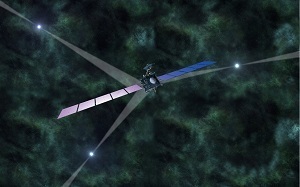
Pulsar beams are tightly focused and sweep around the sky as the pulsar spins. What we’re looking for is a way to place a spacecraft in a three-dimensional frame, taking advantage of the sheer regularity of pulsars by measuring the time of arrival of their pulses, which offer a stability akin to that of atomic clocks. Carrying the right equipment, our space voyagers should be able, in Becker’s view, to position themselves within five kilometers anywhere in the galaxy. As Becker tells the BBC’s Jonathan Amos, “These pulsars are everywhere in the Universe and their flashing is so predictable that it makes such an approach really straightforward.”
Image: Artist’s impression of ESA’s Rosetta spacecraft, imagined as if it navigated in deep space using pulsar signals. Credit: ESA/MPE.
The accuracy of pulsars and their characteristic time signatures amount to a method of navigation that some are likening to GPS satellites and their signals here on Earth. The needed miniaturization for making X-ray detection practical as a navigation tool is on the way, and Becker believes that within fifteen to twenty years, lightweight X-ray mirrors for navigation devices based on pulsar methods will be available for testing. Their advantages may become quickly apparent if the technology is sound. Right now the positioning errors for the Voyager probes amount to several hundred kilometers, using Earth-based antennae and communications travel times to make the call.
I see that the UK’s National Physical Laboratory and the University of Leicester are working with the European Space Agency to investigate pulsar methods, noting that traditional ground-based space navigation is over-taxed, only able to support a limited number of spacecraft at a time. A future pulsar technology would allow spacecraft to handle navigation chores onboard.
So the benefits are near-term but could reach deep into the future. I like Werner Becker’s enthusiasm, as found in this Royal Astronomical Society news release: “Looking forward, it’s incredibly exciting to think that we have now the technology to chart our route to other stars and may even be able to help our descendants take their first steps into interstellar space.” Indeed. While I will always extoll the pleasures of serendipity, I wouldn’t want to be traveling at random on an interstellar journey, just as I was glad last night that Southwest’s crew was keeping an eye on their gauges while I mused on dark landscapes and distant lights as I crossed the continent.






January 14, 2013
The Nuclear Rocket Option
Tim Folger and Les Johnson (NASA MSFC) stood last summer in front of a nuclear rocket at Marshall Space Flight Center in Huntsville, Alabama. Johnson’s work in advanced propulsion concepts is well known to Centauri Dreams readers, but what he was talking to Folger about in an article for National Geographic was an older technology. NERVA, once conceived as part of the propulsion package that would send astronauts to Mars, had in its day the mantle of the next logical step beyond chemical propulsion. A snip from the story:

Johnson looks wistfully at the 40,000-pound engine in front of us… “If we’re going to send people to Mars, this should be considered again,” Johnson says. “You would only need half the propellant of a conventional rocket.” NASA is now designing a conventional rocket to replace the Saturn V, which was retired in 1973, not long after the last manned moon landing. It hasn’t decided where the new rocket will go. The NERVA project ended in 1973 too, without a flight test. Since then, during the space shuttle era, humans haven’t ventured more than 400 miles from Earth.
I’m looking forward to getting back to Huntsville and seeing Les, as well as a number of other friends in the interstellar community, at the 2nd Tennessee Valley Interstellar Workshop, coming up this February, where it may be that NERVA will have a place in the discussion of how we go about building a system-spanning civilization. You’ll want to give Folger’s article a look for comments not only from Les but Freeman Dyson and Andreas Tziolas (from the Icarus team), as well as Elon Musk, the 100 Year Starship’s Mae Jemison, and NASA’s Mason Peck.
Image: NERVA nuclear rocket being tested. (Smithsonian Institution Photo No. 75-13750).
In fact, there are a number of issues presented here that I’ll want to get back to later, but I can’t cover the rest of the story today. I’m all but out the door for a brief but intense period of Tau Zero work that will leave me no time to keep up regular posts here or even to moderate comments. More about this later, and more about Folger’s essay as well, and please bear with me through the temporary slowdown. Things should get back to normal by mid-day Thursday.
Speaking of NERVA, though, I’ll leave you with an interesting petition Gregory Benford alerted me to with regard to the development of nuclear thermal rockets, one that calls for an effort to:
Harness the full intellectual and industrial strength of our universities, national laboratories and private enterprise to rapidly develop and deploy a nuclear thermal rocket (NTR) adaptable to both manned and un-manned space missions. A NTR (which would only operate in outer space) will jump-start our manned space exploration program by reducing inner solar system flight times from months to weeks. This is not new technology; NTRs were tested in the 1960s (President Kennedy was a guest at one test). The physics and engineering are sound. In addition to inspiring young Americans to careers in science, technology, engineering and mathematics, a working NTR will herald a speedy and economical expansion of the human presence in the cosmos.
Going significantly beyond the Moon demands advances in propulsion of the kind that nuclear thermal rockets can deliver. Getting NERVA concepts out of mothballs and updating them with modern materials are necessary steps as we push out into the Solar System.






January 11, 2013
Assessing Exomoon Habitability
Yesterday’s post on exomoons and their possibilities as abodes for life leads naturally to new work from René Heller (Leibniz Institute for Astrophysics, Potsdam) and Rory Barnes (University of Washington). We’re finding planets much larger and more massive than Earth in the habitable zone, as the recent findings of the Planet Hunters project attest. What can we say about the habitability of any large moons these planets may have? In their paper, Heller and Barnes look at the issues that separate exomoon habitability from habitability on an exoplanet itself.
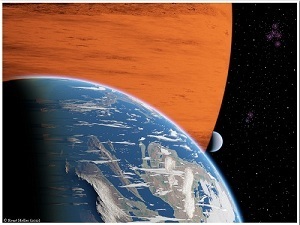
If Earth-sized satellites of giant planets exist, they may have certain advantages over terrestrial planets in the same orbit, depending on the host star. We know that M-class dwarfs are by far the most common kind of star in the galaxy, and that habitable zone planets around one of these will probably be tidally locked, with one hemisphere permanently facing the star and the other in permanent darkness. Extreme weather conditions would result, creating severe limitations on the size of any habitable regions. But an Earth-mass exomoon around a gas giant will be locked not to the star but to the planet, a configuration that could stabilize the climate and prevent the dark side atmosphere from freezing out and the bright side atmosphere from evaporating.
Image: Artist’s conception of two extrasolar moons orbiting a giant gaseous planet. (Credits: R. Heller, AIP)
The stability of the atmosphere remains an issue, though, dependent on the size of the moon, the type of atmosphere and the intensity of incoming radiation. The researchers believe a nitrogen-dominated atmosphere would be stripped away by ionizing extreme ultraviolet radiation (EUV) in some habitable zone situations. This is interesting so let me quote the paper:
If Titan would be moved from its roughly 10AU orbit around the Sun to a distance of 1AU (AU being an astronomical unit, i.e. the average distance between the Sun and the Earth), then it would receive about 100 times more EUV radiation, leading to a rapid loss of its atmosphere due to the moon’s smaller mass, compared to the Earth. For an Earth-mass moon at 1AU from the Sun, EUV radiation would need to be less than seven times the Sun’s present-day EUV emission to allow for a long-term stability of a nitrogen atmosphere. CO2 provides substantial cooling of an atmosphere by infrared radiation, thereby counteracting thermal expansion and protecting an atmosphere’s nitrogen inventory.
For that matter, how massive does a moon need to be to create the magnetic shield that can sustain a long-lived atmosphere, and to drive tectonic activity and support a carbon-silicate cycle? The authors peg the figure at somewhere above 0.25 Earth masses, a figure that can be adjusted depending on the moon’s composition and structure. As I mentioned yesterday, the ongoing Hunt for Exomoons with Kepler (HEK) project pegs 0.2 Earth masses as the minimum size for an exomoon detection using current technology.
How large exomoons form is a question we’ve been kicking around here in the comments. If a gas giant is assumed to have formed well beyond the snow line and then migrated to its position in the habitable zone, would it bring with it a massive enough moon to sustain habitability? One recent paper (Canup and Ward, 2006) has shown that moons formed in the circum-planetary disk of a gas giant will have masses in the range of 10-4 times that of the planet’s mass. The paper runs through formation and capture scenarios and notes the work of Takanori Sasaki (Tokyo Institute of Technology), who suggests the formation of Earth-mass moons is indeed possible. We’re left with evolving ideas in what is clearly an active area of research.
Tidal heating is also a key factor in exomoon habitability, capable of causing intense magmatism and resurfacing on the moon’s surface in close orbits and enough volcanic activity to render the moon uninhabitable. But Heller and Barnes see scenarios where a moon becomes habitable only because of tidal heating, such as when the host planet orbits outside the outer edge of the habitable zone. For that matter, tidal heating can drive plate tectonics. Here the authors point to Europa, where tidal effect provides the heat to sustain a subsurface ocean of liquid water.
A theoretical model emerges, estimating the minimum distance a moon can be from its host planet and still allow habitability. The authors call the inner part of the circum-planetary habitable zone the ‘habitable edge.’ Moons inside the edge can run into runaway greenhouse effects because of tidal heating, while those outside the habitable edge are habitable by definition:
Similar to the circumstellar habitable zone of extrasolar planets… we conclude that more massive exomoons may have somewhat wider habitable zones around their host planets – of which the inner boundary is defined by the habitable edge and the outer boundary by Hill stability – than do less massive satellites. In future investigations it will be necessary to include simulations of the moons’ putative atmospheres and their responses to irradiation and tidal heating. Thus, our irradiation plus tidal heating model should be coupled to an energy balance or global climate model to allow for more realistic descriptions of exomoon habitability.
The minimum distance model for a planet to orbit and still be habitable should come in handy if we do find some candidate moons through the HEK project. “This concept will allow future astronomers to evaluate the habitability of extrasolar moons. There is a habitable zone for exomoons, it’s just a little different than the habitable zone for exoplanets,” Barnes said. But getting spectroscopic biosignatures in the atmospheres of any detected exomoons awaits next-generation space telescopes, so for now we’re left to use orbital configurations and studies of exomoon composition to assess potential habitability. One upcoming positive is the 2022 launch of ESA’s Jupiter Icy Moons Explorer mission, which should offer insights into the massive Galilean moons from tidal effects to surface chemistry and useful data on their interiors.
The paper is Heller and Barnes, “Exomoon habitability constrained by illumination and tidal heating,” accepted by Astrobiology (preprint). A news release from the Leibniz Institute for Astrophysics is available.






January 10, 2013
Gas Giants in the Habitable Zone
Because the sky is full of surprises, we can’t afford to be too doctrinaire about what tomorrow’s discovery might be. After all, ‘hot Jupiters’ were considered wildly unlikely by all but a few, and even here in the Solar System, probes like our Voyagers have turned up one startling thing after another — volcanoes on Io were predicted just before Voyager arrived, but who thought we’d actually see them in the act of erupting? So I don’t think we can rule out the idea of habitable moons around a gas giant in the habitable zone, but there are reasons to question how numerous they would be.
We’ve had this discussion before on Centauri Dreams, and while I love the idea of a huge ‘Jupiter’ hanging in the sky of a verdant, life-bearing planet, there are some factors that argue against it, as reader FrankH pointed out recently. One problem is that moons around a gas giant will probably be made largely of ice and rock, because the planet itself would have formed beyond the snow line and migrated into the habitable zone. A Mars-sized moon is going to melt and, given its low escape velocity, will gradually lose its atmosphere in these warmer regions.
We could imagine capture scenarios as a migrating gas giant moves into the warm inner system, but it’s hard to see that as a frequent occurrence. The key question for me would be what factors govern the formation of gas giant moons in the first place, and what is the likelihood of finding moons much larger than Mars? David Kipping’s continuing exomoon work has suggested we could detect a moon of approximately 0.2 Earth masses with existing technology, but this is far larger than Ganymede, and we have no analog in our own Solar System.
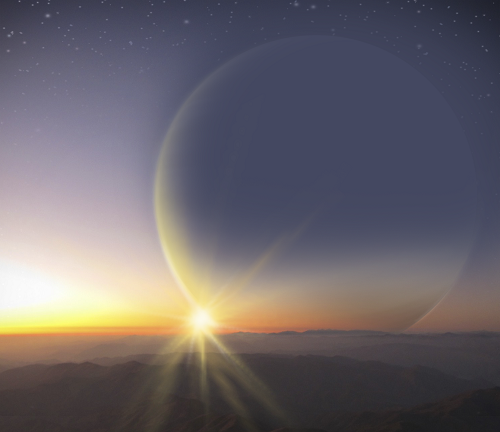
Image: An artist’s rendition of a sunset view from the perspective of an imagined Earth-like moon orbiting the giant planet, PH2 b. The scene is spectacular, but how likely is it that gas giants would have moons beyond Mars size? The answer to the question awaits further work in exomoon detection. Credit: H. Giguere, M. Giguere/Yale University.
So we continue the hunt and the speculation. All this comes to mind because of the discovery of PH2 b-a, the second planet to be confirmed by the Planet Hunters project. The volunteers of Planet Hunters come from all walks of life and use their computers to analyze public domain data from the Kepler mission. The idea behind the project was that humans, with their unique gift of pattern recognition, might see things in light curves that Kepler’s algorithms had missed. Debra Fischer (Yale University), lead scientist for Planet Hunters, champions the idea, particularly in light of the most recent findings, which include a number of other candidates:
“We are seeing the emergence of a new era in the Planet Hunters project where our volunteers seem to be at least as efficient as the computer algorithms at finding planets orbiting at habitable zone distances from the host stars. Now, the hunt is not just targeting any old exoplanet – volunteers are homing in on habitable worlds.”
The estimated surface temperature on PH2 b-a is 46 degrees Celsius, so we are indeed in the habitable zone but without any evidence of moons circling the gas giant. Work with the HIRES spectrograph and NIRC2 adaptive optics system on the Keck telescopes on Mauna Kea has confirmed the existence of the planet, which had been detected by volunteers examining Kepler lightcurves. All told, Planet Hunters identifies in the paper on this work 43 new discoveries, most of which have orbital periods above 100 days. The findings increase the number of gas giant planet candidates with orbital periods over 100 days and radii between Neptune and Jupiter by thirty percent. Nine candidates are members of multi-planet systems. And note this:
Among these new candidates, twenty appear to orbit at distances where the temperature at the top of the atmosphere would be consistent with temperatures in habitable zones. Most of these habitable zone planet candidates have radii comparable to or larger than Neptune; however, one candidate (KIC 4947556) has a radius of 2.60±0.08 R⊕ and may be a SuperEarth or mini-Neptune.
Whether or not the imagined habitable moons exist, this is outstanding work and a tribute to the power of ‘citizen science’ in identifying candidates that the Kepler automatic detection and validation pipeline overlooked. The paper on the latest detections runs through the project’s previous candidates and the confirmed planet PH1 b, an interesting world in a 137-day circumbinary orbit around an eclipsing binary in a quadruple star system. The paper adds that Planet Hunters volunteers are most effective at detecting transit candidates with radii larger than 4 Earth radii, while smaller worlds are best retrieved through mathematical algorithms.
For more, see Ji Wang et al., “Planet Hunters. V. A Confirmed Jupiter-Size Planet in the Habitable Zone and 42 Planet Candidates from the Kepler Archive Data,” submitted to The Astrophysical Journal (preprint).






January 9, 2013
Probing a Brown Dwarf’s Atmosphere
The American Astronomical Society’s meeting in Long Beach is going to occupy us for several days, and not always with exoplanet news. Brown dwarfs, those other recent entrants into the gallery of research targets, continue to make waves as we learn more about their nature and distribution. The hope of finding a brown dwarf closer than Alpha Centauri has faded and recent work has emphasized that there may be fewer of these objects than thought — WISE data point to one brown dwarf for every six stars. But habitable planets around brown dwarfs are not inconceivable, and in any case we are continuing to build the census of nearby objects.
The latest from AAS offers up what could be considered a probe of brown dwarf ‘weather.’ If the idea of weather on a star seems odd, consider that the cooler brown dwarfs are far closer to gas giants than stars, unable to trigger hydrogen fusion and gradually cooling as they age. That means cloud patterns form and huge storms plow through the various atmospheric layers. At AAS, Daniel Apai (University of Arizona) presented the results of work on the brown dwarf 2MASSJ22282889-431026, which he conducted with a team led by the university’s Esther Buenzli. The results are useful not just for brown dwarf study but planetary atmospheres as well.
Using the Hubble and Spitzer space telescopes simultaneously, the researchers found that every ninety minutes the light from the star varied as it rotated. Because they were looking at the object at different wavelengths, they were able to see that the timing of the brightness change depended on wavelength. Some infrared wavelengths emerge from deep within the star, while others are blocked by water vapor and methane at higher altitudes. What we’re getting, in other words, is a look at layers of material being carried around the brown dwarf in likely storms.
But these aren’t your usual clouds, according to Mark Marley (NASA Ames), a co-author on the paper:
“Unlike the water clouds of Earth or the ammonia clouds of Jupiter, clouds on brown dwarfs are composed of hot grains of sand, liquid drops of iron, and other exotic compounds. So this large atmospheric disturbance found by Spitzer and Hubble gives a new meaning to the concept of extreme weather.”
The brown dwarf in question is cool in stellar terms but still hot enough — 600 to 700 degrees Celsius — to produce clouds like those Marley describes. The light variations offer the researchers a chance to understand the brown dwarf’s weather in the vertical dimension. Another scientist involved in the work is Adam Showman, also at the University of Arizona, who notes: “The data suggest regions on the brown dwarf where the weather is cloudy and rich in silicate vapor deep in the atmosphere coincide with balmier, drier conditions at higher altitudes — and vice versa.”
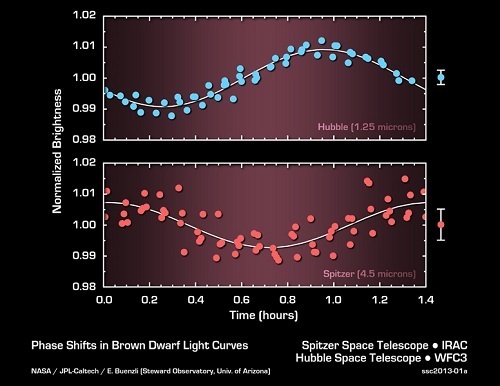
Image: This graph shows the brightness variations of the brown dwarf named 2MASSJ22282889-431026 measured simultaneously by both NASA’s Hubble and Spitzer space telescopes. As the object rotates every 1.4 hours, its emitted light periodically brightens and dims. Surprisingly, the timing, or phase, of the variations in brightness changes when measured at different wavelengths of infrared light. Spitzer and Hubble’s wavelengths probe different layers in the atmosphere of the brown dwarf. The phase shifts indicate complex clouds or weather patterns that change with altitude. Credit: NASA/JPL-Caltech.
A way forward in brown dwarf studies is suggested in the paper:
We have measured longitudinal variability throughout the near-infrared in a T6 dwarf and found an unusual correlation of light curve phase with the pressure probed by a given wavelength, which suggests a complex horizontal and vertical atmospheric structure. Our observations should provide an incentive to drive the development of higher-dimensional atmospheric models in order to gain a deeper understanding of dynamical and radiative processes in brown dwarf and exoplanet atmospheres.
Hubble and Spitzer are thus giving us the ability to probe a brown dwarf atmosphere in ways that, according to Apai, are not dissimilar to how doctors probe the body with medical imaging techniques. The unexpected offset between the different layers of atmospheric material tells us that a feature we might see on the surface of a brown dwarf may have shifted as we push into the inner layers of the object. That’s a sign of wind-driven clouds in constant motion, a warmer version of features like Jupiter’s Great Red Spot on an object not quite planet, not quite star.
The paper is Buenzli et al., “Vertical Atmospheric Structure in a Variable Brown Dwarf: Pressure-dependent Phase Shifts in Simultaneous Hubble Space Telescope-Spitzer Light Curves,” Astrophysical Journal Letters 760 (2012), L31 (preprint).






January 8, 2013
Earth-Sized Planets Widespread in Galaxy
Plenty of interesting news is coming out of the American Astronomical Society meeting in Long Beach CA, enough that I’ll want to spread our look at it out over the next few days. I want to start with Geoff Marcy’s investigations with grad student Erik Petigura at UC-Berkeley, the two working in tandem with Andrew Howard (University of Hawaii) on the question of Earth-sized planets and their distribution in the galaxy. But I can’t help noting before I begin how science fictional all these exoplanets are starting to seem as each day brings a new paper or announcement.
For me, science fiction has always been as much about landscape as it is about science, and exoplanets are the ultimate exercise in imagining exotic places. When exoplanet announcements were still new and we had only a small catalog of these worlds, I would find myself pondering each and thinking about what it would be like to orbit one, or stand on it. Now we’re getting hard data on potentially habitable places that evoke the compelling artwork on the covers of SF magazines I’ve read over the years. People gripe about not having flying cars or humans in the outer system, but to me the future I’ve lived into is every bit as provocative as the one that used to be portrayed in the pages of Astounding or Galaxy.
I spent yesterday afternoon thinking about the upcoming presentation of Marcy’s team at the AAS. They’ve created a new structure within which to analyze Kepler photometry for transiting planets, applying their algorithm to a sample of 12,000 G and K-class stars that were chosen because they are among the most photometrically quiet of Kepler’s targets, and thus best suited for the detection of small planets. The work focused on close-in planets with orbits between 5 and 50 days, Earth-sized worlds that are at the margin of detectability within the Kepler data.
The results show that about 17 percent of all Sun-like stars have planets in the 1-2 Earth diameter range orbiting close to their host stars — here we’re talking about distances within about 0.25 AU, which places these worlds well inside the orbit of Mercury. The team also extrapolates from its results that the fraction of stars having planets of Earth size or a bit bigger orbiting in Earth-like orbits may be as high as 50 percent. Both findings follow from the researchers’ analysis of how often planets of a particular size appear, as Andrew Howard notes:
“Our key result is that the frequency of planets increases as you go to smaller sizes, but it doesn’t increase all the way to Earth-size planets — it stays at a constant level below twice the diameter of Earth.”
In other words, there are more small planets than large ones, with perhaps one percent of stars having planets the size of Jupiter, while 10 percent have planets the size of Neptune. But Petigura’s work goes farther than this, suggesting that the increase in planets as size decreases stops when we get down to planets of about twice Earth’s diameter. The numbers then remain the same until we reach planets the size of the Earth, beyond which this analysis ends. That’s a finding that leaves plenty of room for Earth-like worlds in abundance throughout the galaxy.
Petigura’s work was clearly key for the project because it was he who developed TERRA (Transiting ExoEarth Robust Reduction Algorithm), a program through which the UC-Berkeley team fed 12 quarters of Kepler data. Petigura wanted to find out how many Earth-sized planets Kepler was missing, their faint signals lost in the ‘noise’ of a transit lightcurve. Measuring the fraction of planets Kepler wasn’t seeing, the team was able to extract 119 Earth-like worlds ranging from six times Earth’s diameter all the way down to a planet the size of Mars. Thirty-seven of the team’s planets had not been identified in the previous Kepler work.
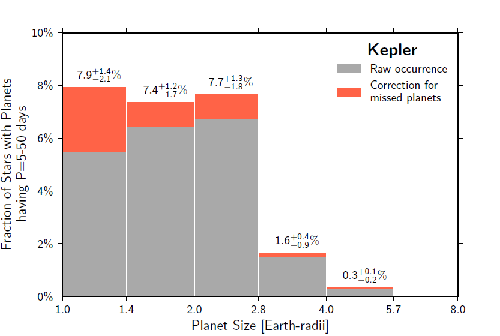
Image: The fraction of Sun-like stars having planets of different sizes, orbiting within 1/4 of the Earth-Sun distance (0.25 AU) of the host star. The graph shows that planets as small as Earth (far left) are relatively common compared to planets 8.0x the size of Earth (similar to Jupiter). For example, 7.9% of Sun-like stars harbor a planet with a size of 1.0-1.4 times the size of Earth, orbiting inward of 1/4 the Earth-Sun distance (closer than Mercury’s distance from the Sun). There are increasing numbers of planets from 8x the size of Earth down to 2.8x Earth. Remarkably, the number of planets smaller than 2.8x Earth is approximately constant with planet size, down to the size of our Earth. The gray indicates the planets discovered in this study, and the orange represents the correction applied to account for planets the TERRA software would miss statistically, typically about 20%. Credit: Image by Erik Petigura and Geoff Marcy, UC Berkeley, and Andrew Howard, Institute for Astronomy, University of Hawaii.
This study takes us another step along the way to a major exoplanet goal. Getting a sound estimate of the fraction of Sun-like stars bearing Earth-sized planets in the habitable zone — eta Earth — is tantalizingly close, and the paper on this work points out that its 12,000 stars will be among the sample from which this estimate is drawn. The Berkeley team homes in on close-in planets as a way of studying planet frequency in relation to size, the assumption being that estimates of habitable zone ‘Earths’ will tighten as we get further data. From the paper:
Our key result is the plateau of planet occurrence for the size range 1–2.8 RE for planets having periods 5-50 days. With 8 years of total photometry in an extended Kepler mission (compared to 3 years here), the computational machinery of TERRA— including its light curve de-trending, transit search, and completeness calibration—will enable a measurement of [eta Earth] for habitable zone orbits with extended mission photometry.
All in all, the team estimates that uncertainties in detection mean that Kepler misses about one in four big Earth-sized worlds, a figure this work now corrects. Planets larger than Earth in this category may often turn out to be more like Neptune than Earth, with a rocky core surrounded by helium and hydrogen — planets like these may, in close orbits, be water worlds with vast oceans and no exposed land surface. But the UC-Berkeley work gives us plenty of reason to think that rocky worlds like Earth within stellar habitable zones are going to be anything but rare.






January 7, 2013
On Artifacts Future and Past
How are you affected by the cave paintings at Lascaux? The paleolithic art in this region of southwestern France dates back perhaps 18,000 years, depicting large animal figures, human forms and abstract symbols. Some believe the paintings even contain astronomical pointers — star charts — but theories on how to interpret them abound, and whatever spin we put on them, we’re confronted by the mystery of evocative imagery reaching out over centuries. Lascaux and other such sites take us beyond civilization and into the realm of deep time, a place where our parochial concerns are dwarfed by this reminder of humanity’s aggregated experience.
Early cave art reaches almost twice as far back as the 10,000 year clock proposed by Danny Hillis and the Long Now Foundation hopes to take us forward. Yet the experience of the two is in some ways similar. Building a clock designed to tell time by the year and century places our short lives in perspective and demands we take a view that encompasses our remote descendants. Long-term thinking, forward or back, is about identifying the forces shaping the human experience and asking what we can do today to influence an outcome we will never live to see.
In some ways, artifacts like the Voyager Golden Record are cousins of the cave paintings, for they collect various statements about who we are and project them into the realm of deep time. It’s equally hard to imagine what far future audience the cave painters might have had in mind, if any, and what audience the Golden Records might one day achieve. But for chance we might never have learned about Lascaux, the paintings of which were discovered by a French teenager in 1940. And what chance is there that some extraterrestrial civilization may one day recover an intact Voyager, long silent but bearing the testimony of the record that identifies its makers?

Image: One of the cave paintings of Lascaux, a chance discovery that brought the early human experience to vivid life. Credit: Wikimedia Commons.
I’m thinking about Lascaux this morning because a scene from the cave art is one of the images chosen by writer and artist Trevor Paglen for a multimedia project called The Last Pictures, an archive of 100 black and white photographic images launched into geosynchronous orbit aboard a communications satellite in November. Paglen had been contemplating the fact that most satellites in low Earth orbits eventually return to Earth, forced down by the inexorable processes of orbital decay. But communications satellites, almost 36,000 kilometers above the equator, are up there for good. “These satellites are the longest-lasting things that humans have ever made,” Paglen told The Atlantic’s Austin Considine in a recent interview. “Very few, if any, traces of human civilization [will remain] on the surface of the earth. But a ring of dead satellites and spaceships will remain in orbit, essentially, forever.”
So Paglen set about choosing photographs that would record the human experience, working with artists, scientists, philosophers and anthropologists to decide how to encapsulate it. Drawing on the expertise of a team at MIT and weighing the physical constraints for an archive he saw as lasting several billion years, the chosen images were etched into a silicon wafer that was bolted along with its protective shell onto the EchoStar XVI, a satellite operated by Dish Network. The satellite is expected to carry programming for 15 years, the archive to survive for billions more.
Have a look at Considine’s piece, which reproduces several of the images, including art from Lascaux as well as cherry blossoms against a clear sky, a waterspout in the Florida Keys and a group of orphan refugees from Greece and Armenia wading into the sea for the first time. How you cull 100 images out of the vast possibilities in archives around the world is a story in itself, and it’s clear that Paglen had no didactic agenda in their selection. No captions accompany the satellite-born text (although they are available in an accompanying book available through Paglen’s site). Like the cave paintings, Paglen’s images are evocative without shedding obvious meaning, capable of deep layers of interpretation and conveying a sense of shared experience.
Considine’s interview is itself moody and interesting. Here’s a bit more of it:
Sagan’s records implicitly assumed we would be around for an alien follow-up call. It tried — ambitiously, if somewhat arrogantly — to make a good first impression. “The Last Pictures” assumes it is impossible to say anything universal or lasting about humanity, and that we’ll be long gone by the time its pictures are discovered, if they’re found at all.
“This is not a project that’s supposed to explain to aliens what humans are all about and be the definitive record of human civilization,” Paglen said. It is, he added, “a collection of images that explained to somebody in the future what happened to all of the people who built the dead spaceships in orbit around the earth. And how they killed themselves.” (Or perhaps were killed?)
As art, this is work that proceeds without any certainty of a future audience, and makes its statement by that very ambiguity. If our species works its way through the thousand traps of technological growth and survives, the Paglen photographs become a time capsule of the sort we tend to stick in the cornerstone of buildings, and we can imagine humans of the future looking upon the ancient satellite as no more than a curiosity. If we don’t survive, we can imagine the same faint chance the Voyagers have of being detected and studied by some other intelligence, a thought that adds an almost unbearable poignancy to some of these images.
I wouldn’t want to try to convey the experience of an entire species through any series of images, and with a number as small as 100, the choice seems hopelessly arbitrary. But what gives the work a certain fascination is that we live in an era when we can create something that could outlive its makers not just by millennia but by eons. There will be more such things as we continue to push out into the Solar System, with space probes that continue their journeys long after they have fallen silent, and all will bear witness to the civilization that put them in motion. That in itself is evocative of the deep mystery we all face as we confront our existence, a mystery the cave painters surely felt as they captured hunters, bison and aurochs on walls of ancient stone.






January 4, 2013
Planets Everywhere You Turn
Exactly what kind of planets can form around M-class dwarf stars is a major issue. After all, these stars, comprising 70 percent or more of the stars in the galaxy, are far more common than stars like the G-class Sun. About 5500 of the 160,000 stars the Kepler mission is looking at are M-dwarfs, and of these, 66 had been found to show at least one planetary transit signal at the time a new paper on M-dwarf planets was in preparation. That paper, the work of John Johnson and postdoc Jonathan Swift (Caltech) and team, homes in on the Kepler-32 system, whose five transiting planets offer a chance to study planet formation and frequency around such stars.
Kepler-32 is about half as massive as the Sun and has half its radius, with about 5 percent of its luminosity. The planets here have radii that range from 0.8 to 2.7 times that of the Earth, all of them orbiting within about a tenth of an astronomical unit from the star, a distance that is about a third of the radius of Mercury’s orbit around the Sun. The outermost of the five planets lies in the habitable zone. The Caltech team used Kepler data in correlation with observations from the Keck Observatory and the Palomar 60-inch telescope to characterize the system in detail. Two of the planets had already been confirmed, and the team has now confirmed the other three.
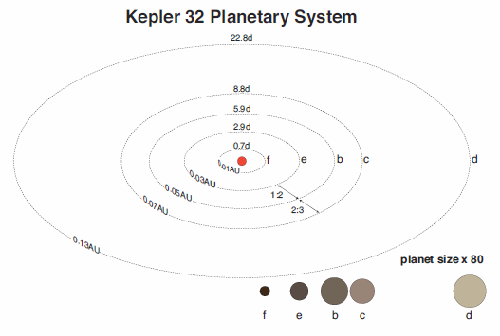
Image: — Depiction of the Kepler-32 planetary system with the star and orbits drawn to scale. The relative sizes of the planets are shown at the bottom of the figure scaled up by a factor of 80 in relation to their orbits. Credit: Jonathan Swift, John Johnson/Caltech.
Although the study is producing interesting material on planet formation, what’s capturing the bulk of press attention is the researchers’ estimate that there are at least 100 billion planets in the galaxy. It’s a conservative figure at that, because the analysis only includes planets in close orbits around M-dwarfs, leaving aside the issue of outer planets in such systems and planets orbiting other classes of star. To arrive at the figure, the team calculated the probability that an M-dwarf system would have the precise edge-on orientation we see with Kepler-32, combining that with the number of systems Kepler is able to detect. Even the conservative figure — essentially one planet for every star in the galaxy — is happy news for planet hunters, for it suggests that planets are the norm around the most common kind of stars in the Milky Way.
From the paper:
We select out 4682 M dwarfs from the Kepler Input Catalog that have been observed with Kepler and use their observational parameters to derive the planet occurrence rate of Kepler M dwarf planet candidates. We confirm that within the completeness limits of the first 6 quarters of Kepler data, the M dwarf planet candidates have an occurrence rate about 3 times that of solar-type stars, while the occurrence rate of all candidates around M dwarfs is 1.0±0.1. We expect the fidelity of our culled sample to be above 90%. Thus the compact systems of planets around the Kepler M dwarf sample are a major population of planets throughout the Galaxy amplifying the significance of the insights gleaned from Kepler-32.
The likelihood is that the five Kepler-32 planets formed much further out from the star and migrated inwards, one line of evidence being that the mass of the disk where the planets are found would be as much as three Jupiters, too much disk material for the space available based on our understanding of other proto-planetary disks. Moreover, the fact that M-dwarfs are brighter and hotter when young would have kept planet-forming dust from existing so close to the star. Yet a third line of reasoning is that the third and fourth planets of the system are not dense, implying they are composed of volatiles like carbon dioxide, methane or other ices and gases. Thus formation further out in the system with subsequent migration is the likely scenario.
The paper is Swift et al., “Characterizing the Cool KOIs IV: Kepler-32 as a prototype for the formation of compact planetary systems throughout the Galaxy,” accepted at The Astrophysical Journal (preprint).
Related: The Planetary Habitability Laboratory (University of Puerto Rico at Arecibo) notes that of the 18,406 ‘planet-like detection events’ released last month by the Kepler team, some 15,847 meet the criteria for study for possible inclusion in the institution’s Habitable Exoplanet Catalog. PHL analyzed and sorted the remaining candidates and was able to identify 262 potentially habitable worlds. These include four Mars-sized objects, 23 of Earth size, and 235 ‘super-Earths.’ The best candidate PHL sees thus far is an Earth-sized planet in a 231-day orbit around the star KIC-6210395, one that receives 70 percent of the light that Earth receives from the Sun. This interesting if preliminary analysis is reported in a news release wonderfully titled (with a nod to ‘Contact’) ‘My God, it’s full of planets! They should have sent a poet.’






Paul Gilster's Blog
- Paul Gilster's profile
- 7 followers



